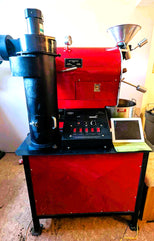
Coffee Roasting: New Coffee Roaster Considerations
We often receive inquiries from people just starting out on their new coffee business venture. We decided to write up several key considerations to keep in mind when evaluating types of new coffee roasters to purchase or whether to make that investment into a used coffee roaster.
The first strategy should include an understanding of the target market and preferences. Analyzing the competition in your area and or online is important as this can help you identify gaps in the market and what your unique selling points will offer.
A business plan that outlines your goals, budgets, and marketing strategies provides a roadmap to ensure success. Calculation of startup costs, ongoing expenses, and revenue potential. What is your business model going to be? Brick & mortar, a drive-through, and or hybrid to include online sales and subscriptions. What is the traffic count and access? A demographic study can provide useful and relevant information.
Location, location, location. Choose an appropriate location for your roasting facility, considering the ordinances, business license, and whether you are strictly coffee roasting or coffee roasting and service to the public.
Regarding equipment, we recommend investing in high-quality coffee roasting machines and related equipment to minimize the risk of mechanical problems. One needs to consider the equipment's capacity, automation, and energy efficiency. Remember that new coffee roasters can take six months to over a year to produce. This is where used coffee roasting equipment can be an excellent choice when first starting out.
Once the coffee roasting machine is selected, relationships with coffee bean suppliers or direct sourcing from coffee farms become crucial to ensure consistent and reliable supply chain function.
Roasting profiles come next for your business to develop and fine-tune how you want to achieve your desired flavor profiles for your target market. What will your customers like? What do they prefer, a strong roast or one that is lighter? Contemplate the different roast levels and types of beans you want to offer customers.
Creating a strong brand identity, logo, appealing design, and informative packaging for your coffee products should fit your target market and demographic location.
Always do your homework with legal and regulatory compliance with local, state, and federal regulations for the appropriate permits and if serving food – food safety and labeling.
The following is a “to-do” list guide to consider:
- Quality Control: Implement rigorous quality control measures throughout the coffee roasting process and train staff on quality assessment and consistency.
- Distribution and Sales Channels: Explore various distribution channels such as wholesale, retail, online sales, and cafe partnerships. Developing a marketing strategy to promote your coffee brand is a wise investment of time.
- Pricing: Determine competitive pricing that covers your costs and allows for profit margins; consider offering different pricing tiers for wholesale and retail customers.
- Sustainability: Explore sustainable sourcing, roasting, and packaging practices. Maintain communication of your commitment to sustainability for your eco-conscious consumers.
- Staffing: Hire skilled roasters and staff with knowledge and a passion for people and coffee. Provide them with training and ongoing education to maintain quality standards for your operations.
- Financing: Secure the necessary funding. Options include loans, investors, family, friends, crowdfunding, and personal funding.
- Expansion Plans: Consider your long-term growth strategy, including potential expansion into new locations or product lines for future growth.
- Customer Feedback: Always a terrific way to improve your products and services is to collect and act on customer feedback for improvement.
- Adaptability: A must in these times. Stay informed about the coffee industry trends and be willing to adapt to changing consumer preferences.
Lastly, starting a new coffee roasting business requires careful planning and execution. Considering all these factors and conducting research can increase your chances of building a successful and sustainable coffee-roasting venture.
We are here to help you in any way we can.


Leave a comment